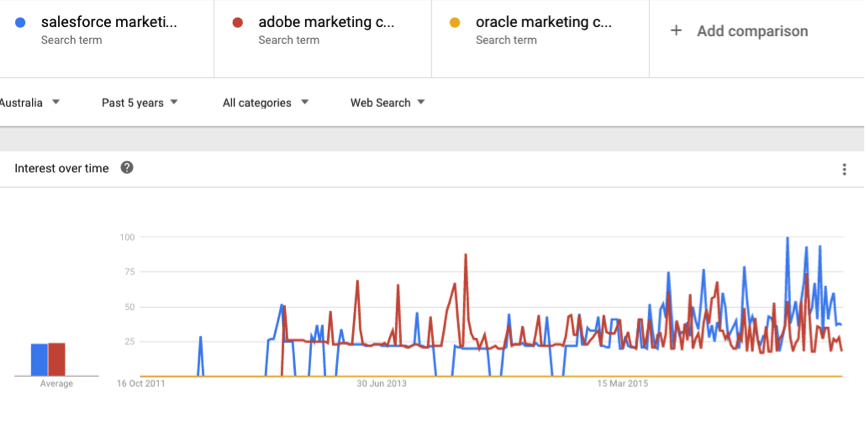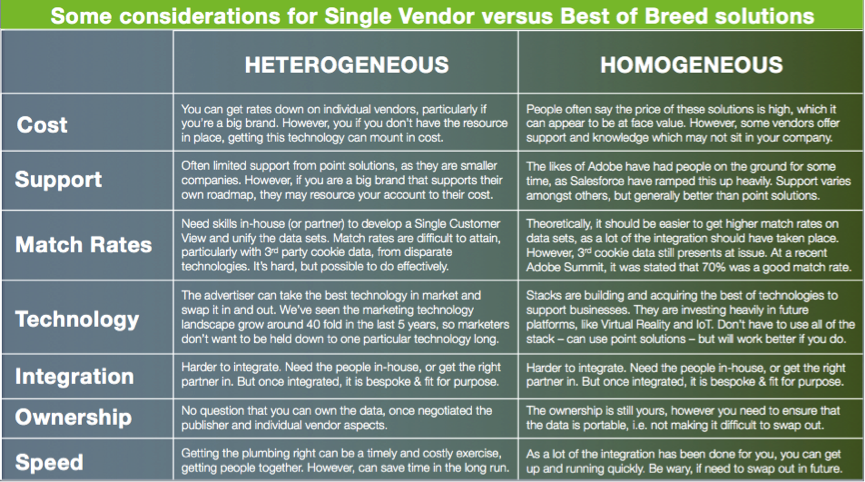Helping APAC Marketers Assess Single-Vendor Vs Best-of-Breed


With technology playing an increasingly important role in driving digital transformation and customer engagement, marketers are starting to debate the merits of integrating best-of-breed technologies or deploying a single-vendor solution. In this week's industry byliner, Oakton's senior principal consultant Chris Dutton looks at the pros and cons of both models and how advertisers can go about assessing their options.
According to the fourth annual Digital Marketing Performance Dashboard, by the CMO Council & Adobe, one-third of Australian marketers have adopted the tools needed to give them a progressive and disciplined approach to digital. This is a dozen points above their Asia-Pacific counterparts.
Australia sees data as a competitive differentiator in driving a better customer experience. With this wealth of data, businesses have a unified view of their customers and, to an extent, their prospects and action-relevant messaging: at an individual level, at key moments of receptivity, on the device they are using at that time, and, within the correct channel, and format.

Chris Dutton, Senior Principal Consultant, Oakton
This is possible through marketing and advertising technologies that had once been siloed. In order to achieve this effective cross-channel personalised messaging, companies can either connect the technologies they have and bring in best-of-breed technologies – forming what's known as a 'heterogeneous stack' – or they can go with a single vendor that has bought pre-integrated technologies to do the same thing, or what we commonly call a 'homogeneous stack'.
To date, Australian marketers have integrated point solutions, for the most part. According to a January 2016 eConsultancy survey of 450 marketers in Australia and New Zealand, 51% of client-side respondents said they used integrated point solutions, while just 11% used a single vendor's stack or marketing cloud solution.
In case you're wondering what happened to the remaining 38%, these marketers use non-integrated point solutions and have a way to catch up. Whilst point-solution integration seems to be advancing, the prominence of the single stack is in the ascendency and has made large inroads over a relatively short period of time.
The rise of single-stack solutions has only come about in the last few years. The Google Trends image (below) represents the searches, in Australia, for marketing cloud solutions.
Clearly, it's only in the last four years that Australian marketers have began to look for these stacks.
Drivers behind stack ascendency
The advent of the symposiums and summits has brought a lot of attractive case studies and product roadmap innovations to light. With it, comes a sense that marketers have to keep up with their counterparts, both here and abroad.
The focus of these events is often, quite rightly, on delivering a better customer experience. Attendees are frequently C-level advertisers who lean on their staff and partners to get from point A to B in the shortest time possible; and these single solutions offer the technology, roadmap, and support to do this.
This is a very attractive proposition in the face of growing and complex technology sets – more than 3,800 marketing technologies at last count – an increasingly competitive landscape, the digital 'disruption' taking place in their respective industries, and resourcing issues, including a dearth of relevant skillsets.
The stacks also have mounted their presence in market. For instance, Adobe really ramped up their marketing solution support heavily a few years ago, while Salesforce recently have gone through an enormous recruitment drive. Their capabilities are also mounting all the time. Adobe have spent over USD$3bn (£2.43bn) building out their products for Adobe Marketing Cloud, while Salesforce's recent purchase of Krux bring their acquisition total for 2016 to almost USD$5bn (£4.05bn).
Industry experts had projected these marketing technologies would come down to a two-horse race, eventually. And if you were going to place your chips, you wouldn't be chastised for saying Salesforce and Adobe.
A key differentiator here will be that Adobe have a CMS, while Salesforce's heritage is around their CRM. However, you also have Oracle and IBM in the mix and they have also made sizeable acquisitions.
In their recent 'Digital Experience Platform Vendor Landscape' report, Forrester highlighted three categories: 'Enterprise Cloud', encompassing the likes of Oracle and IBM; 'Suite', with Adobe and Sitecore; and 'Microsuite', such as Qubit.
Enterprise Cloud vendors have revenues in excess of USD$10bn (£8.1bn), with a global footprint, and routinely support three or more business functions. Suites typically have revenues in excess of USD$100m (£80.97m), with a regional footprint, and routinely support one primary and one secondary business function. Microsuites, on the other hand, have a wide range of revenues and footprints, but routinely either support a single business function or act as a core platform component.
In addition to these players, we have Google and Facebook that are building up their own technology environment. For instance, Google now have onsite personalisation technology through to attribution, and are slowly developing their own ecosystem. However, I would argue that because of their 'walled garden', and the fact that marketing automation will also prove near impossible, their technology ecosystem eventually will support and integrate with that of others.
Benefits of homogeneous & heterogeneous stacks
So, which architecture is better? I like to use the analogy of a Swiss Army knife.
It has been said that single-vendor solutions typically take a bunch of tools – none of which are best-in-class – and integrate them together. The argument behind this is: "Why would I want to be locked into a bunch of pseudo-integrated, second-class technologies, without truly owning data?" However, the likes of Salesforce and Adobe have gone to great lengths to integrate these solutions.
It can take a couple of years to properly integrate a technology following a merger and acquisition. These technologies also are rarely second-rate. It's no great secret that Oracle have often taken the approach of acquiring point solutions that sit in the top right-hand quadrant of vendor reports.
I've worked with heterogeneous and homogeneous solutions and they each have merits and shortfalls. Below are some of those considerations:

So, how do you pick the right solution for your organisation? Call it sitting on the fence, but I believe there is no black and white answer. It depends on what is important for your business.
When thinking about a marketing technology solution, many factors must be considered. In either scenario, you have to:
1. Start with a solid understanding of your customers' experiences and journeys. Technology is here to support the experience, not to shoehorn it the other way around.
2. Map out your marketing technology and data points. This is no mean feat and often miscalculated, so enlist help if needed. Marketers tend to underestimate the number of marketing technologies employed by two-fold and sometimes up to 10 times.
3. Align your customer's journey with the supporting technologies and data, and along the conversion funnel.
4. Understand the pain-points and priorities for your organisation, as one solution may suit you best. For instance, if operational cost and lack of resource are key issues, you may want to consider the support that a single stack can provide.
5. Run proof-of-concepts. It's also an agile and iterative process. Capture channel wins and C-level support.
6. Get teams on the same page. Get IT, marketing, sales, PR, and media together and agree on the objectives from the start.
As customer expectations rise, so does the pressure on the advertiser to deliver on those expectations. That pressure trickles down to all partners. The advertiser can reap the benefit, as much as the customer does.
Whichever tech path the advertiser chooses to adopt, it needs to be carefully considered, well implemented, robustly tested, and executed to good effect, with a long-term view.
Ad TechAdvertiserAPACAustraliaDataTechnology








Follow ExchangeWire